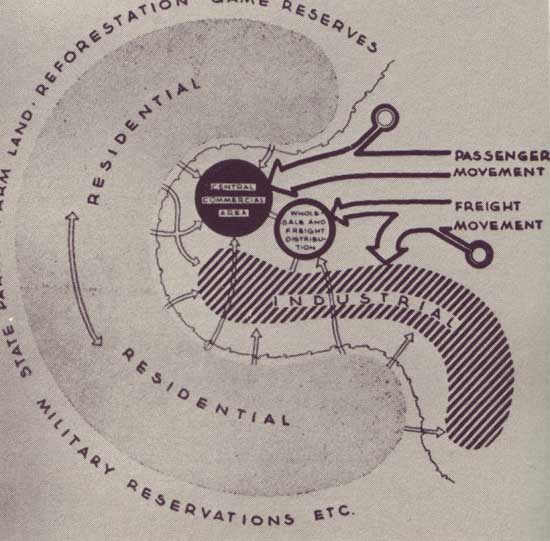

240 rationalist planning
Civitas reduced
to a flow chart. A schematic diagram of a progressively planned
city, made by federal government's National Resources Planning
Board in 1943, as part of a pilot project to teach cities the
virtues of rationalist planning. The drawing displays some of the major
planning dogmas of the age, notably the separation of uses that
would make downtown a preserve of commercial uses only, and
segregate all housing in a sanitized suburb. The real city this
schematic represents was Tacoma, Washington.
Daniel Burnham's Chicago Plan, for all the attention to detail and careful, utilitarian thought behind it, had been a plan in the old manner, something Hippodamus of Miletus or Pope Sixtus V would have understood and appreciated-a civic vision, expressed in physical space. It would be one of the last of its kind. A new brand of planning was gradually coming to dominate the field, one more in tune with a rationalistic age. Our own tradition of design, broken after American independence and the Land Ordinance of 1785, had been picked up off the ground by Burnham and the men of his generation. Their work was part of a worldwide movement, finding much of its inspiration in Europe. 'Town planning' was a phrase first used in 1905 or 1906, perhaps by the British urbanist Raymond Unwin; Stadtplan had been around in German since the 1860's, and it was old methodical Germany that had showed the way for everyone else. In a sense, the triumph of planning in the US was due less to the chaotic neglect in the 19th century than the sudden ambition of the City Beautiful builders. If you're going to take the trouble to lay out a boulevard, you'll find you need controls on land use to keep it fine. If you want to group new public buildings in a formal civic center, the old forgotten art of urban design comes in handy. When ideas finally hit America, they often take hold with surprising speed. Hartford, Connecticut started the first city planning commission in 1907. Harvard began the first university course in 1909, the same year that saw the first National Conference on Planning. In the 20's planning became deeply planted in academia. Harvard opened the first graduate school of city planning in 1929, followed by MIT in 1933 and Cornell and Columbia in '37. Scientistic planning was an important part of the wider movement towards bureaucratization of all government functions, where the worth of employees would be measured by academic training, certification and membership in professional societies. Besides the planners, social and health workers, educators and even educated policemen were becoming 'experts'. Some of the advocates of planning shared the utopian outlook of socialists, communists and devotees of all the other ideologies of that bizarre and unfortunate age. Others had Sumner's message of the survival of the fittest in the back of their minds, and they wanted to make sure they were on the winning side. What both had in common was a nearly unanimous acceptance of the fashionable scientism of the day, and its promise of magically whisking away all problems. So whether they came at the problem from the left or the right, they tended increasingly to see planning as more an engineering problem than a design problem. First of all, we'll need more statistics, studies, surveys, and a permanent planning staff. After that, the idea of comprehensive planning, tying every urban issue together in one big package, seemed possible and necessary. Traffic was a new worry, and a plan could show where new roads were needed. Transportation, sanitation, recreation, every function of the city would have a place in the 'master plan'. Each would have its needs determined and provided for by scientific analysis. A lot of the people in the movement frankly hated the cities of their day, especially New York, where most of them lived. They tended to see the future in terms they had learned from the British Garden Cities movement. Difficult as it may be for us to appreciate now, the majority of these activists of the City Practical boiled all urban problems down to a single, all-encompassing evil: 'overcrowding', or in other words, population density. This was Lewis Mumford'sspecial villain; he felt about it the way temperance ladies felt about whiskey, and the words 'congestion or 'overcrowding' appear on almost every page of his works in the 30's. It was a myth born in the truly overcrowded slums of lower Manhattan, where population densities surpassed those of Calcutta, but one that had little relevance to the rest of the country, where the poor had lots more room. Nevertheless, to the faithful, crime, disease, juvenile delinquency, divorce, political machines and corruption, school dropouts, prostitution, poker playing, whooping cough, cockfights, cockroaches and 'corner loungers' whistling at girls-all had their root in 'overcrowding'. The obvious remedy for all these ills would be government intervention, in the form of socialized housing schemes, or a conscious, planned suburbanization of the working class. For many, it meant comprehensive planning in which the state would assume control of the real estate market and eliminate the iniquities caused by capitalist speculation. The drive to empty out cities began as an outgrowth of the settlement house movement. In 1907, Lillian Wald, Florence Kelley and other well-known activists founded the Committee on Congestion of Population. At least one Progressive, Frederick Howe, saw correctly that the constant outward movement of the middle class would leave plenty of sound housing for workingmen and their families to 'move up'. But the time was right for this idea of radical decentralization. Most Progressives swallowed it whole. The CCP rapidly became a very influential institution, enough so to seize hold of the young planning movement and change its outlook and its principles forever. Its leader, Benjamin Marsh, wrote a popular book called An Introduction to City Planning: Democracy's Challenge to the American City, and in the same year (1909), he organized the first National Conference on City Planning in Washington. Marsh and other conference speakers used the occasion to bushwhack the City Beautiful, deriding its concern with parks and squares, and calling instead for zoning, height limits, planning commissions, and federal regulation of land values and real estate profits. Scientism's assault on the City Beautiful continued in the following years. For many of the planners, it was simply an opportunity for broadening the vision of 'planning', though we need not be cynics to imagine that more mundane, less idealistic factors were involved. As historian William H. Wilson puts it, in The City Beautiful Movement: The city practical long ago prevailed over the City Beautiful, in a fight that was less over two distinct approaches to planning,-the aesthetic and the practical-and more about vocational and professional dominance, appeals to the taxpayer's pocketbook, and bureaucratic control. To oversimplify somewhat, the architects, engineers and others fighting for the city practical beat the landscape architects and architects representing the City Beautiful. The city practical hung on the City Beautiful the labels aesthetics-obsessed, socially primitive and inutilitarian, and made them stick.' |
|

|